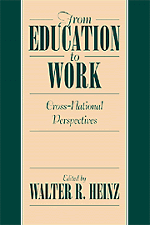Book contents
- Frontmatter
- Contents
- Contributing Authors
- Preface
- Introduction: Transitions to Employment in a Cross-National Perspective
- Part I Social Origin, Gender, and Transition Patterns
- Part II Education and Labour Markets: Work Experiences, Skills, and Credentials
- Part III Changes in the Social Context of Transitions
- 10 Institutional Networks and Informal Strategies for Improving Work Entry for Youths
- 11 School-to-Work Transitions and Postmodern Values: What's Changing in Canada?
- 12 Education and Employment in Great Britain: The Polarizing Impact of the Market
- 13 From Systems to Networks: The Reconstruction of Youth Transitions in Europe
- References
- Index
11 - School-to-Work Transitions and Postmodern Values: What's Changing in Canada?
Published online by Cambridge University Press: 30 September 2009
- Frontmatter
- Contents
- Contributing Authors
- Preface
- Introduction: Transitions to Employment in a Cross-National Perspective
- Part I Social Origin, Gender, and Transition Patterns
- Part II Education and Labour Markets: Work Experiences, Skills, and Credentials
- Part III Changes in the Social Context of Transitions
- 10 Institutional Networks and Informal Strategies for Improving Work Entry for Youths
- 11 School-to-Work Transitions and Postmodern Values: What's Changing in Canada?
- 12 Education and Employment in Great Britain: The Polarizing Impact of the Market
- 13 From Systems to Networks: The Reconstruction of Youth Transitions in Europe
- References
- Index
Summary
The Graduates: Out of School, Out of Work
(Maclean's, June 22, 1992, p. 40)Generation Faces Grim Job Outlook: Underemployment, Cutbacks Stunt Twentysomethings' Careers
(Globe and Mail, September 6, 1993, p. B1)Want a Job after Graduation? Good Luck
(Globe and Mail, March 17, 1995, p. A9)Grads' Day of Glory: For an Instant, Smiles Outshine Gloom Surrounding Job Outlook
(Edmonton Journal, June 10, 1995, p. B1)Job Vacuum Sucks Graduates' Hopes
(Globe and Mail, October 3, 1995, p. 8)Headlines like these capture recent public concerns in Canada about the labor-market problems of youth. Policy makers frequently echo these sentiments, as did the federal minister of human resources when he stated that “[w]e're going to have a lost generation in front of us if we don't work fast” (Edmonton Journal, November 6, 1993, p. A3). Images of a lost generation of youths were also prominent during the recession of 1981–1982, when youth unemployment reached record post–World War II heights of over 20%. In response, a number of new youth-oriented employment programs and training schemes were introduced. The problem seemed to solve itself, however, when the economy began to recover in the mid-1980s and the last of the large cohort of “baby boomers” moved out of the education system into the workforce.
- Type
- Chapter
- Information
- From Education to WorkCross National Perspectives, pp. 260 - 283Publisher: Cambridge University PressPrint publication year: 1999
- 6
- Cited by



